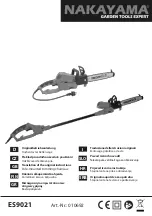
13
Turn the saw right side up so it stands on the table legs.
Adjust the additional braces (27) so that they touch the ground.
Raise the saw blade (5) with the crank (6) to the highest
position.
Remove the table insert (12).
Loosen the screw (A) and insert the blade guard (8) into
the receiver.
Adjust the distance between saw blade and riving knife
(8). The distance must be between 3 and 8 mm.
Retighten the screw (A).
Attach the safety guard (7) to the riving knife (8).
Do not tighten the screw (B). The safety guard must
lower itself again to the table top on its own after lifting it.
Slide the extraction hose (9) on the connection piece of
the safety guard (7) and on the extractor neck (18) on the
housing.
Fasten the stop bar (11A) on the transverse stop.
Place the pushstick (19) in its holder.
Preparing for commissioning
To achieve flawless functioning of the machine, please
follow the instructions listed:
Place the saw in a place that fulfils the following conditions:
secured against slipping
free of vibrations
even
free of tripping hazards
adequate light
Before each use, check
Connection cables for defects (cracks, cuts, etc.)
Do not use any defective cables.
that the guard is in a proper condition
-
Inspect the safety guard for visible damages. Do not use
damaged safety guards.
-
Lift the safety guard and then release it. It must lower
down to the saw table on its own.
the splitting wedge setting
(see splitting wedge setting)
that the table insert is in a proper condition
Immediately replace a worn or damaged table insert (Worn
sawing gap)
whether the pushstick is to hand
Always use the original push stick
the saw blade for flawless condition
Do not use any cracked saw blades or such that have
changed their shape.
Do not use any saw blades made of HSS steel.
Commissioning
Rotational direction of the saw blade
Ensure that the rotational direction of the saw blade is the
same as the rotational direction given on the guard.
Selection of saw blades
Consider when selecting the saw blade, that no
edgeless or damaged saw bands are used and that the
diameter of the blade location hole is 30 mm.
Do not use saw blades made of high speed steel (HSS)
since this steel is hard and brittle; use only tools according
to EN 847-1.
The use of other tools and other accessories may
present a risk of injury to you.
Pay attention that the saw blade conforms with the
dimensions specified under "Technical Data" and is suitable
for the work piece material.
The saw blade supplied as a standard is suitable for timber and
most plastics.
Suitable saw blades must be selected for other
materials to be cut.
When sawing plastic, avoid overheating of the
sawtooth tips to prevent the material to be cut from
melting.
Mains connection
Compare the voltage given on the machine model plate e.g.
220 – 240 V with the mains voltage and connect the saw to the
relevant and properly earthed plug.
Use the connection or extension cable according to IEC 60245
(H 07 RN-F) with a core cross-profile section of at least
1.5 mm2 for cable lengths up to 25m
2.5 mm2 for cable lengths over 25m
Alternating current motor:
Use a shockproof plug, mains voltage 220 – 240 V with residual
current circuit breaker (FI switch 30 mA).
Main fuse: 10 A inert
Power system impedance
In case of disadvantageous power system conditions short-term
voltage reductions can occur during the event of switching on of
the device which can influence other devices (e.g. jittering of a
lamp).
Such influences are not expected at a system impedance of
Z
max
0,346
Ω
.
Summary of Contents for T 250 Eco-3
Page 30: ...29 DIN EN ISO 3744 LWA 107 dB A LpA 94 dB A 3 dB II E 2012 19 EC MDF HM EN 847 1 250 mm HSS...
Page 32: ...31 2 4 3 4 3 29 27 27 5 6 12 A 8 8 3 8 mm A 7 8 B 9 7 18 11A 19 HSS 30 mm HSS EN 847 1...
Page 34: ...33 0 45 1 15 2 14 0 45 3 15 11 C 11 13 D 13 25 25 1 13 24 2 25 3 150 19 30 mm 24A 50 mm...
Page 35: ...34 361700 300 400 mm 80 100 mm 15 20 mm 11 11 HSS 7 12 30 31 31 23 22 5 5 6 8 3 8 mm A A...
Page 36: ...35...















































